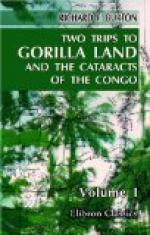On the Fernao Vaz there are now (1873) five factories, each named after some French town: Paris Factory, however, had fallen to ruins, the traders having migrated 150 miles higher up the Kamma River. Here a certain drunken kinglet, “Rampano,” breaks everything he finds in the house, and pays damages when he returns to his senses. On March 31st there was a violent quarrel between the women of two settlements, and the “reguli” embarked with all their host, to fight it out; Rampano was the victor, and after the usual palaver the vanquished was compelled to pay a heavy fine. M. du Chaillu’s descriptions of the country, a park land dotted with tree-mottes, are confirmed; but the sport, excepting hippopotamus, was poor, and the negroes were found eating a white-faced monkey—mere cannibalism amongst the coast tribes. The fauna and flora of the Ogobe are those of the Gaboon, and the variety of beautiful parrots is especially remarked.
On January 9, 1874, M. de Compiegne passed from the Fernao Vaz through the Obango Canal into the Ogobe, which, bordered by Fetish rocks, flows through vast forests; his object was to study the manners and customs of the Kammas, a more important tribe than is generally supposed, far outnumbering the Urungus of the coast. Their country is large and contains many factories, the traders securing allies by marrying native women. The principal items of import are dry goods, guns, common spirits, and American tobacco; profits must be large, as what costs in France one franc eighty cents, here sells for ten francs’ worth of goods. The exports are almost entirely comprised in gum mastic and ivory. At the factory of Mr. Watkins the traveller secured certain figures which he calls “idols”—they are by no means fitted for the drawing-room table. He also noticed the “peace of the household,” a strip of manatus nerve, at times used by paterfamilias.
Mr. R. B. N. Walker, who made sundry excursions between 1866 and 1873, also wrote from Elobe that he had left the French explorers, mm. de Compiegne and Marche, on the Okanda River which M. du Chaillu believes to be the northern fork of the Ogobe. Their letters (Feb. 12, 1874) were dated from Osse in the Okanda country, where they had made arrangements with the kinglet for a journey to the “Otjebos,” probably the Moshebo or Moshobo cannibals of the “Gorilla Book.” The rocks, shoals, and stony bottom of the Ogobe reduced their rate of progress to three miles a day, and, after four wearisome stages, they reached a village of Bakele. Here they saw the slave-driving tribe “Okota,” whose appearance did not prepossess them and whose chief attempted unsuccessfully to stop the expedition. They did not leave before collecting specimens of the language.




